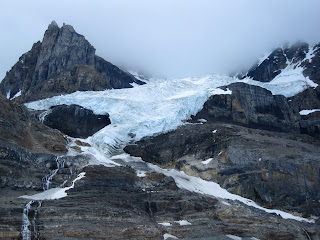


So, I've had a few days to learn about glaciers. Nimmi and I saw lots of them in Jasper and Banff, and had a crash course at the Columbia Icefield center in Banff. After I dropped her off in Calgary, I continued on to Waterton Lakes and Glacier National Parks, in Alberta, Canada, and Montana, USA. I'll talk more about the national parks in a separate post. But since all of these parks are mountainous, and the lakes are glacial lakes, here are some things I've learned about glaciers, in the meantime:
- A glacier is essentially a river of ice. Yes, a river. And just like a river, a glacier flows. It literally moves down the mountain.
- Glaciers form when the amount of snow that falls in an area is more than the amount of snow that melts in that same area. They therefore form from a build-up of snow over time.
- The snow in the mass is subjected to tremendous pressure, and the snow firms up and over time, turns to ice.
- A large mass of ice which is stationary at the top of a mountain is called an "icefield".
- At some point, the pressure exerted on the lower layers of snow from the higher layers becomes tremendous. When this happens, the lowest layer begins to move down the mountain, to "flow". At that point, the mass becomes a glacier.
- Also due to extreme pressure, air is forced out of the mass. Air causes snow/ice to reflect white light; as the air is forced out of the mass, the glacier reflects blue light, and so appears blue.
- As the glacier flows down the mountain, it carves the rock it flows over. The larger pieces of rock are deposited on the sides and at the bottom of the glacier, and are called "moraine". When Nimmi and I hiked both at Edith Cavell and Six Glaciers, we were basically hiking through moraine.
- Glacier carves rock even to very fine, dust-like particles, called "rock flour". When the glacier melts in the summertime, the rock flour flows with the melting ice into the water, causing it to look milky -- which is why Lake Louise, and other glacial lakes, appear milky.
- Rock flour also causes the coloration of glacier-fed lakes. At Lake Louise, the rock flour is primarily limestone, giving the green color to the water.
- Two primary forces are at work on a glacier at any given time: (a) the amount of snow/ice which falls on the glacier and enlarges it; and (b) the amount of melt which occurs on the glacier each summer. If more melting occurs in the summer than water deposited on it in the winter, the glacier shrinks. If more deposition occurs than melting, the glacier grows.
- The "toe", or front edge, of the glacier changes its position all the time. If the glacier moves forward more than it melts, than the toe advances. If the glacier melts more than it moves forward, then the toe recedes.
- Due to friction against rock, the sides of a glacier move more slowly than the center does.
- Also due to friction, the bottom layer of a glacier moves more slowly than the top layers do.
- A glacier only becomes a glacier when it starts flowing. And a glacier ceases to be a glacier when it stops flowing. Therefore, if a glacier recedes to the point where it no longer flows, then it ceases to be a glacier.
- All of the glaciers in the world are receding at unprecedented rates. The primary thought is that this is likely a result of climate change, but this is not definite. All glaciers go through periods of recession in between ice ages, so it is possible that this is simply one of those interim periods.
- All of the glaciers in Glacier National Park (in Montana) will be gone by the year 2030. Yep, you heard me. Gone. Disappeared. Kaput.
So that's it, at least for now. I had a lot of questions about glaciers, and hope you've learned from my questioning. The pictures I've attached are, from top to bottom:
- Athabasca Glacier, attached to the Columbia Icefield
- Andromeda Glacier, also attached to the Columbia Icefield
- Angel Glacier (at the top, spreading its wings), Cavell Glacier (around the pond, looking like it's covered with dirt), and Cavell Pond, which is fed by Cavell Glacier.
The other interesting point is about Snow Dome glacier which is the only glacier in the world to feed into 3 oceans - arctic, atlantic, and pacific.
ReplyDelete